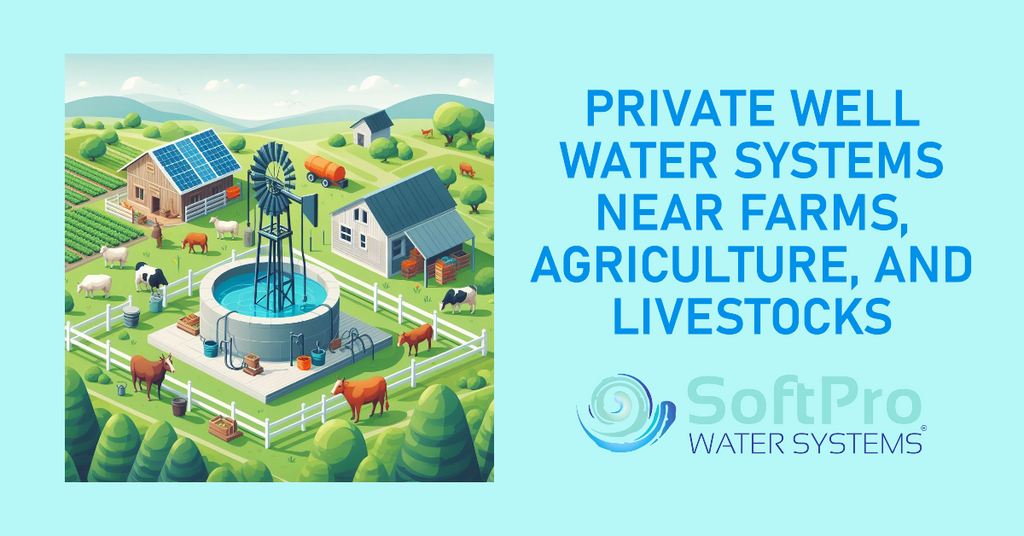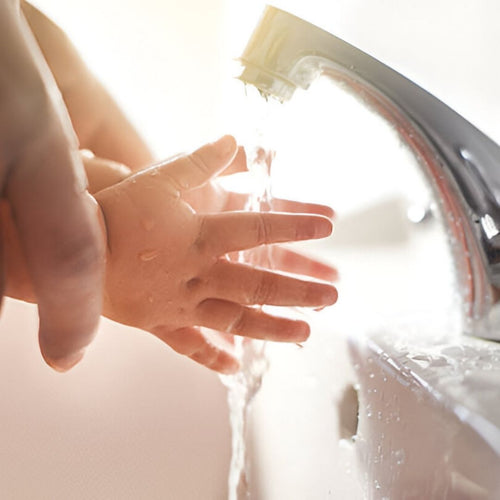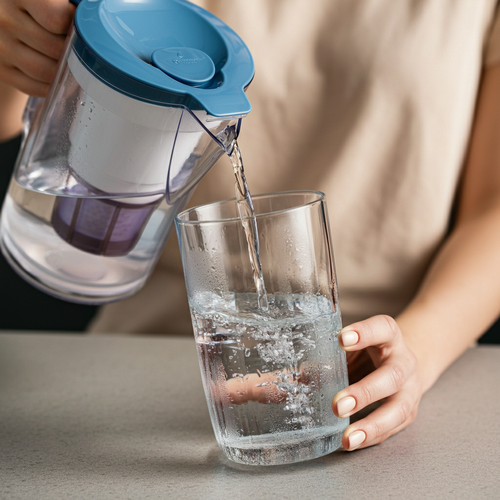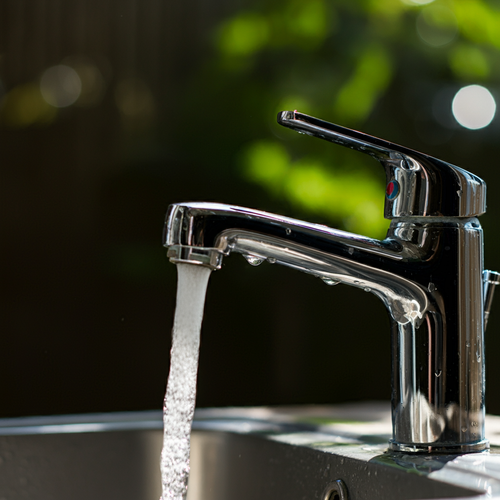If you rely on a private well for your water and live near agricultural operations, you must be aware of the potential impact farming practices can have on your water quality. Contaminants like nitrates from fertilizer, bacteria from livestock waste, and pesticides used to protect crops can seep into the groundwater that supplies your well, posing risks to your health.
Water safety is a significant concern for residents of rural communities around the world. Unlike those on municipal water systems, private well owners are responsible for ensuring the safety of their own water supply. This responsibility becomes even more critical when wells are located in areas with intensive agriculture. Understanding the potential risks, implementing protective measures, and regularly testing your well water are essential steps to safeguarding your family's health. SoftPro Water Systems specializes in providing clean, safe water solutions, and we understand the unique challenges faced by those with private wells near farms.
How Does Farming Affect Private Well Water Quality?
Understanding how farming practices can influence your well water quality empowers you to take proactive steps to safeguard your health. Here's a breakdown of the primary contaminants of concern and how they can enter your well.
Nitrates
- A type of inorganic nitrogen essential for plant growth.
- Excessive nitrate levels in drinking water can cause a serious health condition called methemoglobinemia, also known as "blue baby syndrome." This condition reduces the blood's ability to carry oxygen, particularly impacting infants under six months old.
- Sources of nitrate contamination in well water include:
-
Fertilizers:
- Commercial fertilizers applied to agricultural fields are a major source of nitrate runoff.
- When these fertilizers are not absorbed by crops, they can dissolve in rainwater and percolate through the soil, eventually reaching the groundwater that feeds your well.
-
Manure:
- Animal manure used as fertilizer can also contribute to nitrate contamination, especially if not stored or applied properly.
- Improper storage allows nitrate-laden liquid manure to seep into the ground, while overapplying manure can overwhelm the soil's ability to absorb the nitrogen, leading to runoff.
-
Fertilizers:
Bacteria
- Microscopic organisms, some of which can cause illness in humans.
- Common bacterial contaminants in well water include E. coli and coliform bacteria.
- Sources of bacterial contamination from farms include:
-
Livestock manure:
- Livestock waste contains bacteria that can contaminate nearby water sources if not managed effectively.
- Manure storage facilities with leaks or spills, or manure spread too close to wells, can all contribute to bacterial infiltration into groundwater.
-
Failing septic systems:
- Septic systems from farmsteads or rural residences can also leak sewage effluent into the soil, introducing harmful bacteria that can travel to wells.
-
Livestock manure:
Pesticides
- Chemical substances used to control insects, weeds, and other pests on crops.
- While regulations aim to minimize risks, some pesticides can reach groundwater through:
- Spray drift: Fine particles of pesticides can become airborne during application and travel to nearby wells.
- Leaching: Over time, some pesticides can dissolve in water and percolate through the soil, contaminating groundwater.
Pathways of Contamination
The journey of these contaminants from farm fields to your well water can occur through two primary pathways:
- Surface runoff: This is the movement of water across the ground during rain or irrigation events. Contaminated runoff can flow into streams, ditches, or directly infiltrate the soil near your well.
- Seepage into groundwater: As water percolates through the soil, it can dissolve and carry contaminants with it, eventually reaching the aquifer that supplies your well.
Risk Factors
Several factors influence the vulnerability of your well water to agricultural contamination:
-
Well construction:
- Older wells with shallow depths or compromised casings (the lining that prevents surface water from entering) are more susceptible to contamination.
-
Soil type:
- Sandy or fractured rock soils allow for faster movement of water and contaminants compared to clay soils.
-
Proximity to contamination sources:
- The closer your well is to agricultural activities, the higher the potential risk of contamination.
Should I Be Worried About My Well Water If I Live Near a Farm?
Living near a farm doesn't automatically mean your well water is unsafe. Several factors influence the risk, and responsible agricultural practices can significantly reduce contamination. Here's a breakdown to help you navigate this concern:
-
Variability in Farm Operations:
- Farms differ in size, types of crops or livestock raised, and their approach to land management.
- Large-scale industrial agriculture with intensive fertilizer and pesticide use may pose a higher risk than smaller, organic farms that prioritize sustainable practices.
-
Regulations and Best Practices:
- Government regulations and industry best practices aim to minimize agricultural contamination of water sources.
- These regulations may cover manure storage, fertilizer application rates, and buffer zones around wells and waterways.
The Importance of Testing
Regardless of your proximity to farms, regular testing is the only definitive way to determine if your well water is safe for drinking. Here's why testing is essential:
- Peace of Mind: Knowing your water quality empowers you to make informed decisions about its consumption.
-
Early Detection: Regular testing can identify potential contamination issues before they pose serious health risks.
- For example, a well test might reveal elevated nitrate levels, prompting you to investigate potential sources and take corrective actions such as switching to bottled water for infants or installing a nitrate filtration system.
Statistics on Well Water Contamination
According to a study by Purdue University, nearly 4.5% of private wells tested in Indiana exceeded the safe drinking water standard for nitrates. This statistic highlights the importance of well water testing, even in areas with seemingly low-risk agricultural activity.
Visual Indicators of Contamination
While not foolproof, some visual indicators can suggest potential problems with your well water:
- Cloudy appearance: This could indicate high levels of sediment, bacteria, or other contaminants.
- Unusual odor: A strong metallic or chemical smell might suggest contamination from metals, pesticides, or other substances.
- Changes in taste: Salty, bitter, or metallic tastes can sometimes signal the presence of contaminants.
If you experience any of these visual indicators, it's crucial to have your well water tested immediately.
How Can I Protect My Well Water From Agricultural Contamination?
Proactive measures can significantly safeguard your well water from agricultural contaminants. Here's a two-pronged approach combining well maintenance and promoting best practices on neighboring farms.
Well Inspection and Maintenance
-
Regular Inspections: Schedule annual inspections by a licensed well inspector to ensure the well's structural integrity and identify any potential problems.
- A well inspector will examine the well casing, cap, and vent for cracks or damage that could allow surface water or contaminants to enter. They will also measure water levels and flow rates to assess the well's overall health.
-
Proper Well Cap and Casing: Ensure your well has a secure, sealed cap to prevent contaminants from entering the top.
- The well casing, typically constructed of steel or plastic, should be in good condition and free of cracks or holes that could allow contaminated water to seep in from the surrounding soil.
- Upgrading an older well with a compromised casing may be necessary to ensure proper protection.
-
Wellhead Protection: Maintain the area around your well to prevent surface water pooling or runoff contaminating the wellhead.
- Grading the ground around the well to slope away from the well creates a natural drainage pattern that diverts water away from the well casing.
Best Management Practices for Farms
While you may not have direct control over neighboring farms, you can encourage practices that minimize contamination risks:
-
Nutrient Management Plans: Advise farmers to develop and implement nutrient management plans for fertilizer application.
- These plans consider factors like soil nutrient levels and crop needs, optimizing fertilizer use and minimizing the risk of excess nutrients leaching into groundwater.
- Manure Storage and Management: Proper manure storage facilities with leak prevention features and composting techniques can significantly reduce the risk of bacterial contamination from livestock waste.
-
Buffer Strips: Encourage planting vegetative buffer strips around fields and waterways.
- These buffer zones act as natural filters, trapping sediment and contaminants before they reach wells or streams.
Additional Resources
For more comprehensive information on protecting your well water from agricultural contamination, here are some valuable resources:
- Farm-A-Syst Fact Sheet: Protect Your Well Water provides a detailed guide on well maintenance and best practices for protecting your water source.
- Contact your local Soil and Water Conservation District or state Department of Agriculture. These government agencies offer valuable resources and technical assistance to farmers and residents on water quality protection strategies.
What to Do If Your Well Water is Contaminated
If you suspect or have confirmed contamination of your well water, immediate action is crucial to protect your health. Here's a roadmap to navigate this situation:
-
Stop Drinking the Water: As a first step, discontinue using your well water for drinking, cooking, or food preparation.
-
Seek an Alternative Water Source: Bottled water is a safe alternative until your well water is treated and retested.
-
Contact Your Local Health Department: They will provide guidance on proper well water testing procedures and can recommend qualified well water treatment professionals.
- Public Health Agencies: These government bodies play a vital role in safeguarding public health, and their local environmental health departments are responsible for overseeing private well water quality. They can advise on testing requirements, health risks associated with specific contaminants, and available treatment options.
Treatment Options
The most appropriate treatment method depends on the specific contaminant identified in your well water testing. Here are some common options:
-
Distillation: This process boils water to produce steam, which is then collected as pure water, leaving contaminants behind. Distillation is effective in removing a wide range of contaminants, including bacteria, nitrates, and heavy metals.
-
Reverse Osmosis: A technology that utilizes a semi-permeable membrane to filter out contaminants from water. Reverse osmosis systems are effective against a variety of contaminants, including dissolved salts, minerals, and some pesticides.
-
Specialized Filtration Systems: Depending on the specific contaminant, specialized filtration systems may be necessary. For example, anion exchange filtration systems can effectively remove nitrates from well water.
-
Chlorination: While effective in eliminating bacteria, chlorination typically requires additional filtration steps to address other contaminants.
- This method is often used as a first-line treatment for bacteriological contamination, followed by filtration to remove any residual chlorine taste or odor and remaining contaminants.
Addressing the Source of Contamination
If your well water tests positive for contamination, it's crucial to identify and address the source. This may involve:
- Working with Neighboring Farms: Discuss your test results with neighboring farms to explore ways to implement best management practices that can minimize future contamination risks.
- Reporting to Local Authorities: In some cases, depending on the severity of the contamination and its source, you may need to report the issue to your local health department or environmental protection agency. These agencies have the authority to investigate and enforce regulations aimed at protecting water quality.
Additional Considerations for Protecting Your Well Water from Agricultural Contamination
Living near farms while relying on a private well for your water supply necessitates a proactive approach. Here are some additional factors to consider that can influence your well water's safety and long-term protection:
Regulations on Well Water Safety and Agricultural Practices
- Safe Drinking Water Act (SDWA): This federal law sets enforceable standards for drinking water quality in the United States. The Environmental Protection Agency (EPA) is responsible for enforcing the SDWA, including setting maximum contaminant levels (MCLs) for various contaminants that can be present in drinking water.
- State and Local Regulations: Individual states and localities may have additional regulations specific to well water quality and agricultural practices. These regulations may address well construction standards, testing requirements, or buffer zones around wells to protect them from contamination.
- Researching and understanding the relevant regulations in your area empowers you to advocate for your well water safety and ensure compliance with established standards.
The Role of Well Depth and Geology
- Well Depth: Generally, deeper wells are less susceptible to surface contamination sources like agricultural runoff. The depth at which groundwater becomes less vulnerable to contamination varies depending on local geology.
- Geological Formations: The type of rock or soil layers underlying your well can influence how quickly contaminants can migrate from the surface to the groundwater. For example, clay layers can act as a natural barrier to contamination, while fractured rock formations may allow contaminants to move more readily.
Long-Term Health Effects of Chronic Exposure to Low-Level Contaminants
While some contaminants may cause immediate health problems at high levels of exposure, others can pose health risks through chronic low-level exposure. For example, nitrates at levels exceeding the MCL can cause methemoglobinemia in infants, but long-term exposure to lower levels of nitrates may also be linked to certain health problems like thyroid issues and certain cancers.
Regular Testing is Essential
Contamination levels can fluctuate over time, so even if your well water tested safe in the past, regular testing remains essential. The frequency of testing may vary depending on your well's location, risk factors, and any previous contamination concerns. Consulting with your local health department or a qualified well water professional can help determine an appropriate testing schedule for your situation.
Protecting Your Well Water in Agricultural Areas
Living near farms raises concerns about the safety of well water. Contamination from fertilizers, pesticides, and manure can pose health risks, making it vital to understand the potential impact of agricultural activities on groundwater quality. Regular testing, well maintenance, and promoting best practices on neighboring farms are crucial for safeguarding your water supply. While regulations exist, the responsibility for ensuring a private well's water quality ultimately lies with the individual well owner.
Key Takeaways
- Agricultural practices can introduce harmful contaminants, particularly nitrates, bacteria, and pesticides, into groundwater that feeds your well.
- The risk of contamination depends on factors such as well construction, proximity to potential contaminant sources, and soil type.
- Regular well water testing is the only way to ascertain its safety for consumption.
- Proactive measures like well inspection, proper wellhead protection, and encouraging sustainable farming practices minimize contamination risks.
- If contamination is identified, address the issue by stopping the use of contaminated water, pursuing appropriate treatment options, and working with relevant authorities to address the source.
Don't wait to safeguard your water supply
If you live near agricultural operations and rely on a private well:
- Schedule a professional well inspection and water test.
- Contact your local Soil and Water Conservation District or health department for resources and support.
- Learn more about promoting sustainable farming practices in your community
At SoftPro Water Systems, we're committed to helping you access safe and healthy water. Get in touch with us today if you have concerns about your private well water and explore our comprehensive water treatment solutions.


















![Aldex Premium 10% Cross Link Resin for Water Softener [High Capacity]-SoftPro® Water Systems](http://www.softprowatersystems.com/cdn/shop/files/Aldex_10_Cross_Link_Resin_Premium_High_Capacity_for_Water_Softener_600x.jpg?v=1735853599)




















